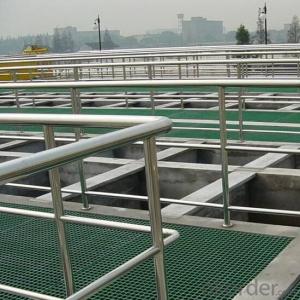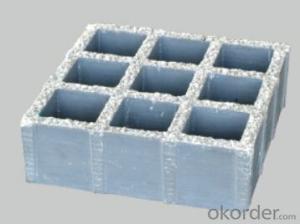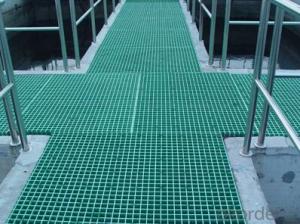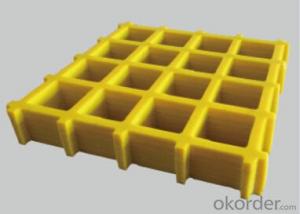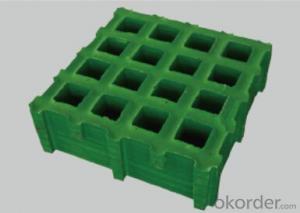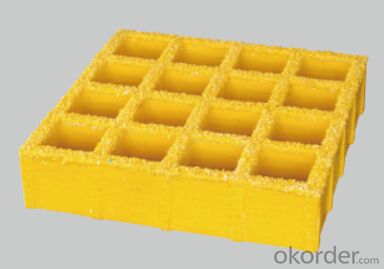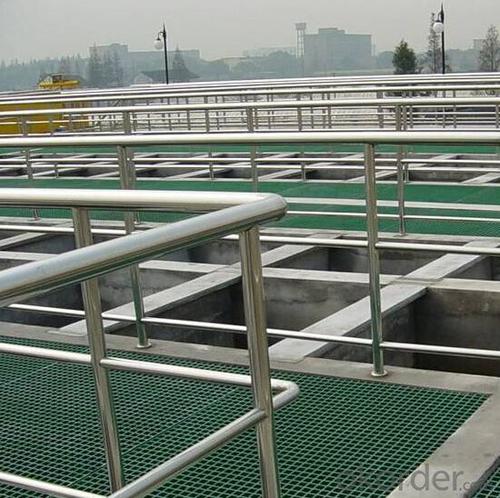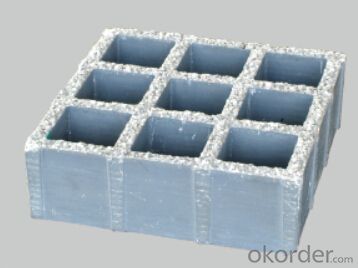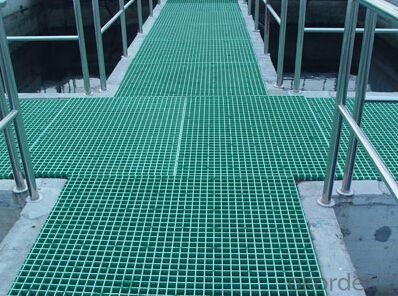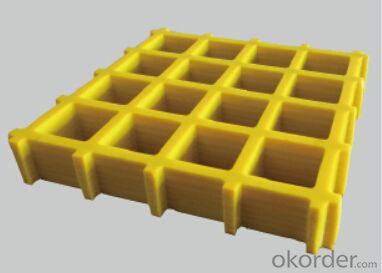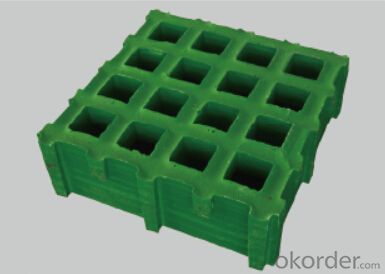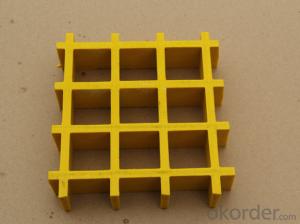FRP Pultrusion Profiles Gratings - Superior Slip Resistance for Sewage Treatment Facilities
- Loading Port:
- Shanghai
- Payment Terms:
- TT OR LC
- Min Order Qty:
- 10 pc
- Supply Capability:
- 8000 pc/month
OKorder Service Pledge
OKorder Financial Service
You Might Also Like
Specification:
FRP molded grating made of vertical and horizontal continuous fiberglass fully soaked in unsaturated polyester resin giving perfect bi-directional mechanical properties. Combining unmatched corrosion resistance with strength, long life and safety, molded grating provide the ultimate in reliable performance, even in the most demanding corrosive conditions. Besides, it is easy to cut and install. CNBM offer the widest selection with panel sizes, colors and slip resistant surfaces, clients can avail FRP grating your specific requirements.
Product Features:
- Light but high loaded strength
- High anti-corrosion and anti-aging
- Easy installation and maintenance
- Low maintenance
- Non-conductive
- Lowest in life cycle cost
- Corrosion Resstance
- Anti-slippery
- Various sizes and color available
Colour Design:
To satisfy customer's design project, CNBM grating offers a wide selection of grating colors to choose from. The standard colors available for fiberglass grating as following:
- Blue
- Red
- Yellow
- Green
- Light Grey
- Dark Grey
Custom colors of fiberglass grating may be available upon request, you can contact us learn more.
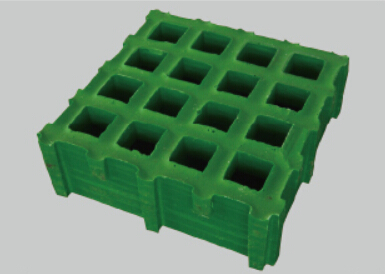
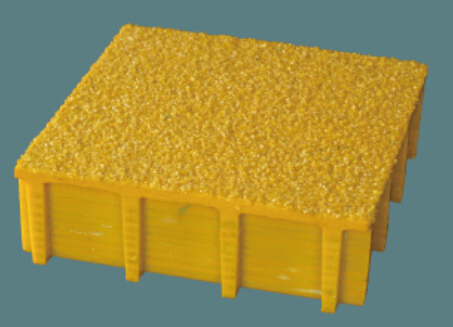
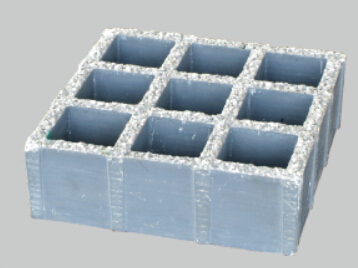
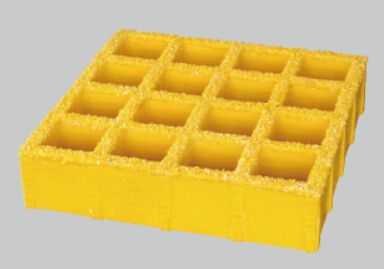
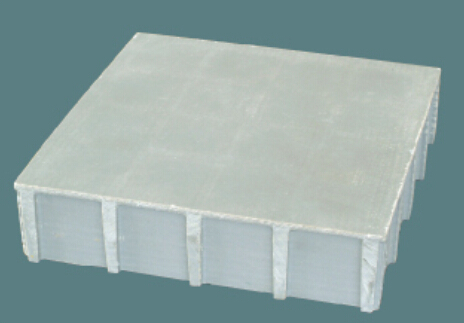
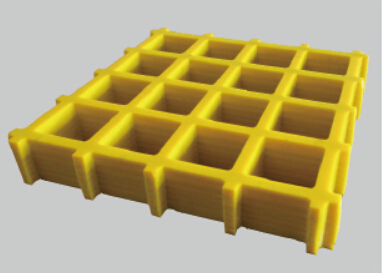
- Q: Are FRP pultrusion profiles resistant to chemicals used in pharmaceutical manufacturing?
- FRP pultrusion profiles are well-known for their resistance to chemicals utilized in the pharmaceutical manufacturing industry. These profiles are created by saturating fibers with a resin matrix, typically polyester or vinyl ester. This resin matrix offers exceptional chemical resistance, allowing the profiles to endure exposure to a wide variety of chemicals, including acids, alkalis, solvents, and cleaning agents frequently employed in pharmaceutical manufacturing procedures. Due to the combination of fiber reinforcement and a chemical-resistant resin matrix, FRP pultrusion profiles are an excellent option for applications that involve contact with aggressive chemicals. Unlike traditional materials such as steel or wood, FRP profiles do not corrode or undergo chemical reactions when in contact with substances. Moreover, FRP pultrusion profiles provide numerous additional benefits for pharmaceutical manufacturing applications. They possess a remarkable strength-to-weight ratio, are non-conductive, and exhibit high mechanical resistance. Furthermore, FRP is a non-porous material, preventing the absorption or release of chemicals. This characteristic is crucial for maintaining strict hygiene standards and preventing contamination in pharmaceutical processes. In conclusion, FRP pultrusion profiles are a dependable and long-lasting choice for pharmaceutical manufacturing environments, offering excellent resistance to the chemicals typically encountered in these processes.
- Q: Are FRP pultrusion profiles resistant to chemicals used in semiconductor manufacturing?
- FRP pultrusion profiles have a general resistance to chemicals typically employed in semiconductor manufacturing. Known for its exceptional chemical resistance, FRP is a suitable material for various industrial applications, including the semiconductor industry. The composite structure of FRP, which comprises a reinforced fiber matrix embedded in a polymer resin, provides resistance to a broad range of chemicals such as acids, alkalis, solvents, and other aggressive substances commonly used in semiconductor manufacturing processes. This resistance guarantees that FRP pultrusion profiles can endure exposure to these chemicals without significant degradation or corrosion, making them a dependable choice for implementation in semiconductor manufacturing environments. However, it is always advisable to refer to the manufacturer's specific chemical resistance data to ensure compatibility with the particular chemicals and concentrations employed in a specific semiconductor manufacturing process.
- Q: Are FRP pultrusion profiles suitable for the manufacturing of chemical pumps?
- Yes, FRP pultrusion profiles are suitable for the manufacturing of chemical pumps. FRP (Fiber Reinforced Polymer) pultrusion profiles offer several advantages that make them ideal for use in chemical pump manufacturing. Firstly, FRP pultrusion profiles are highly corrosion-resistant. Chemical pumps are frequently exposed to corrosive chemicals, which can cause damage and deterioration to traditional metal pump components. However, FRP pultrusion profiles are made from a combination of fiber reinforcements and a polymer resin matrix, which makes them highly resistant to corrosion from various chemicals. This makes FRP pultrusion profiles an excellent choice for ensuring the longevity and durability of chemical pumps. Secondly, FRP pultrusion profiles have excellent mechanical properties. They have a high strength-to-weight ratio, which means they can withstand high pressures and loads without adding significant weight to the pump. This is important for chemical pumps that need to handle heavy-duty applications and maintain their performance over time. Additionally, FRP pultrusion profiles offer design flexibility. They can be manufactured in various shapes and sizes, allowing for customized designs that meet specific pump requirements. This versatility in design enables manufacturers to optimize the pump performance and efficiency. Moreover, FRP pultrusion profiles are electrically non-conductive. This is particularly advantageous in chemical pump applications, where the presence of electricity can pose a safety risk. By using FRP pultrusion profiles, the risk of electrical accidents is minimized, ensuring a safer working environment. In summary, FRP pultrusion profiles are well-suited for the manufacturing of chemical pumps. Their corrosion resistance, excellent mechanical properties, design flexibility, and electrical non-conductivity make them a reliable and efficient choice for ensuring the performance, durability, and safety of chemical pumps in various industrial applications.
- Q: Can FRP pultrusion profiles be used in the construction of amusement park rides?
- Amusement park rides can utilize FRP pultrusion profiles due to their various advantages. Firstly, these profiles have a high strength-to-weight ratio, making them lighter than steel without compromising structural integrity. Consequently, the weight of the ride's structure can be reduced while maintaining safety. Secondly, FRP pultrusion profiles possess exceptional resistance to corrosion. Unlike steel, they do not rust or deteriorate when exposed to moisture or chemicals commonly found in amusement parks. This makes them ideal for rides constantly exposed to water, humidity, and harsh conditions. Moreover, these profiles offer design flexibility, allowing for customized shapes and sizes that meet specific requirements of amusement park rides. This versatility enables engineers and designers to create intricate and aesthetically pleasing structures. Furthermore, FRP pultrusion profiles provide excellent electrical insulation, ensuring a high level of safety for rides with electrical components and wiring. Additionally, these profiles are non-magnetic, which is advantageous for rides utilizing magnetic systems or sensors. Non-magnetic materials eliminate the risk of interference or disruption to the ride's functionality. Lastly, FRP pultrusion profiles are durable and require minimal maintenance. They are resistant to UV radiation, preventing degradation or fading due to prolonged sunlight exposure. This reduces the need for frequent painting or coating, resulting in lower maintenance costs over time. In conclusion, the combination of lightweight, corrosion resistance, design flexibility, electrical insulation, non-magnetic properties, and durability make FRP pultrusion profiles an excellent choice for constructing amusement park rides.
- Q: Are FRP pultrusion profiles resistant to chemicals used in pharmaceutical packaging?
- FRP pultrusion profiles exhibit a general resistance to chemicals commonly employed in pharmaceutical packaging. These profiles are composed of a blend of reinforced fibers and a polymer resin matrix, resulting in exceptional resistance to chemical substances. The polymer resin utilized in FRP profiles is typically chosen to be compatible with a wide array of chemicals, including those typically used in pharmaceutical packaging. The remarkable chemical resistance of FRP profiles has led to their widespread utilization in various sectors, pharmaceuticals included. They can endure exposure to an extensive range of chemicals, such as acids, bases, solvents, and other aggressive substances frequently encountered in pharmaceutical packaging procedures. This resistance effectively safeguards the packaging's integrity and ensures that the pharmaceutical products remain free from contamination or degradation. Moreover, FRP pultrusion profiles also possess corrosion resistance, which proves advantageous in the pharmaceutical industry where aggressive chemicals may be present. This corrosion resistance further bolsters the durability and longevity of the FRP profiles, establishing them as a dependable choice for pharmaceutical packaging applications. Nonetheless, it is essential to recognize that the specific chemical resistance of FRP pultrusion profiles may vary depending on the type and concentration of chemicals employed. Therefore, it is advisable to consult the manufacturer or supplier of the FRP profiles to ascertain their compatibility with the specific chemicals used in pharmaceutical packaging.
- Q: Are FRP pultrusion profiles UV resistant?
- Yes, FRP (Fiber Reinforced Polymer) pultrusion profiles are typically UV resistant. This is because they are manufactured using a combination of polymer resin and reinforced fibers such as fiberglass. These materials have inherent UV resistant properties, making FRP pultrusion profiles resistant to damage caused by prolonged exposure to sunlight and ultraviolet radiation. UV resistance is a crucial characteristic for outdoor applications where the profiles will be exposed to sunlight, such as in construction, infrastructure, and marine industries. However, it is important to note that the level of UV resistance may vary depending on the specific resin and fiber composition used in the manufacturing process. Therefore, it is recommended to consult the manufacturer or supplier for specific information on the UV resistance of FRP pultrusion profiles for a particular application.
- Q: Can FRP pultrusion profiles be used in the construction of playground equipment?
- Yes, FRP pultrusion profiles can be used in the construction of playground equipment. FRP (Fiber Reinforced Polymer) pultrusion profiles are known for their high strength-to-weight ratio, durability, and resistance to corrosion and weathering. These qualities make them suitable for various applications, including playground equipment, where safety and longevity are important factors. FRP pultrusion profiles can be used to construct slides, climbing structures, handrails, and other components of playground equipment, providing a safe and reliable solution for recreational areas.
- Q: Are FRP pultrusion profiles resistant to saltwater corrosion?
- Indeed, FRP pultrusion profiles exhibit exceptional resistance to saltwater corrosion. Their corrosion resistance is a significant advantage over traditional materials like steel or aluminum. The combination of reinforcing fibers and resin matrix in FRP profiles endows them with inherent resistance to the corrosive effects of saltwater. FRP profiles consist of a blend of glass or carbon fibers that are embedded in a thermosetting resin. These constituents do not chemically react with saltwater, effectively preventing the corrosion commonly observed in metals exposed to saltwater for prolonged periods. Additionally, the resin matrix utilized in FRP profiles acts as a protective barrier, further impeding saltwater from reaching the reinforcing fibers. The corrosion resistance of FRP pultrusion profiles renders them exceptionally suitable for applications in marine settings. Seawalls, dock fenders, offshore platforms, and marine vessels frequently employ FRP profiles due to their durability in saltwater environments. This durability guarantees long-term performance and minimizes the necessity for frequent maintenance or replacement. However, it is crucial to acknowledge that although FRP pultrusion profiles demonstrate high resistance to saltwater corrosion, they can still be influenced by other factors like UV radiation or chemical exposure. Consequently, it is vital to consider the precise environmental conditions and consult manufacturers or experts to select the most appropriate FRP profile for a given application.
- Q: Can FRP pultrusion profiles be used in the renewable energy and solar power industry?
- The renewable energy and solar power industry can effectively utilize FRP (Fiber Reinforced Polymer) pultrusion profiles. These profiles possess several key characteristics that make them ideal for such applications. To begin with, the high strength-to-weight ratio of FRP pultrusion profiles is crucial in the renewable energy sector. They are lightweight yet strong, allowing them to withstand various environmental conditions while remaining cost-effective. Additionally, these profiles offer excellent corrosion resistance, ensuring durability and longevity in outdoor and potentially corrosive environments like solar power plants or wind farms. Moreover, FRP pultrusion profiles have outstanding electrical insulation properties, making them suitable for electrical applications commonly found in the renewable energy industry. Furthermore, these profiles can be easily customized into various shapes and sizes, enabling the design and engineering of complex structures required for solar power installations or wind turbine blades. Furthermore, FRP materials are non-conductive and non-magnetic, ensuring their safety for use in electrical and magnetic fields associated with renewable energy systems. In conclusion, FRP pultrusion profiles provide a combination of strength, durability, lightweight, corrosion resistance, and electrical insulation properties that make them highly suitable for use in the renewable energy and solar power industry.
- Q: Do FRP pultrusion profiles have any limitations or drawbacks?
- Yes, FRP pultrusion profiles do have certain limitations and drawbacks. One limitation is that FRP pultrusion profiles have lower stiffness compared to traditional materials like steel or aluminum. This means that they may not be suitable for applications that require high structural rigidity or heavy loads. Another limitation is that FRP pultrusion profiles are prone to creep, which is the gradual deformation of the material under a constant load over time. This can negatively affect the long-term performance and durability of the profiles, especially in applications where they are subjected to sustained stress. Additionally, FRP pultrusion profiles are generally more expensive to produce compared to traditional materials. The manufacturing process involves pultruding continuous fibers through a resin matrix, which requires specialized equipment and expertise. This can result in higher production costs, making FRP pultrusion profiles less cost-effective for certain applications. Furthermore, FRP pultrusion profiles are generally not suitable for high-temperature applications. The resin matrix used in their production can degrade or soften at elevated temperatures, limiting their use in environments where thermal resistance is critical. Lastly, FRP pultrusion profiles may have limited design flexibility compared to other materials. The pultrusion process typically produces profiles with constant cross-sections and limited geometric complexity. This can restrict their use in applications that require intricate shapes or customized designs. Despite these limitations and drawbacks, FRP pultrusion profiles offer several advantages such as high strength-to-weight ratio, corrosion resistance, and electrical insulation properties. It is important to carefully consider the specific requirements of the application before opting for FRP pultrusion profiles.
Send your message to us
FRP Pultrusion Profiles Gratings - Superior Slip Resistance for Sewage Treatment Facilities
- Loading Port:
- Shanghai
- Payment Terms:
- TT OR LC
- Min Order Qty:
- 10 pc
- Supply Capability:
- 8000 pc/month
OKorder Service Pledge
OKorder Financial Service
Similar products
Hot products
Hot Searches
Related keywords

